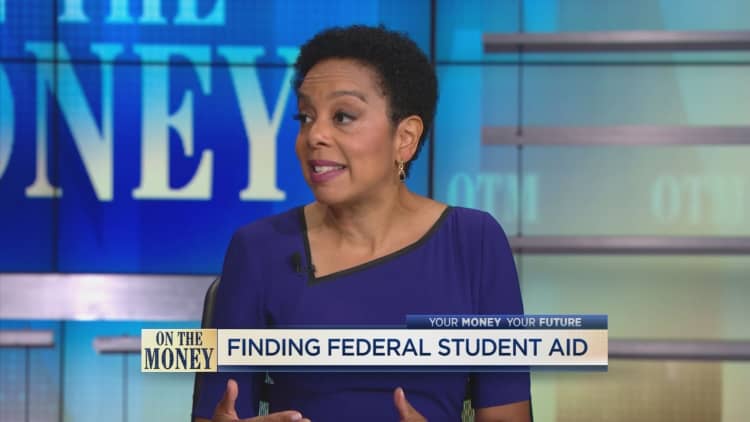

For many families, financial aid is key when it comes to paying for college.
But students must first fill out the Free Application for Federal Student Aid to access any assistance. And this year, the FAFSA has been significantly delayed.
For the 2024-2025 school year, a new, streamlined FAFSA form will be available on or before Dec. 31, 2023, up to nearly three months later than in previous years. (The Education Department said it plans to return to an Oct. 1 start date next year.)
“The irony is they are changing the FAFSA to make it simpler and easier but in doing that, you’ve created a problem,” said Mary Morris, CEO of Virginia529, one of the largest 529 plans in the country. For families trying to navigate the process, a new formula and the delay are “intimidating and scary and annoying.”
More from Personal Finance:
Fewer students are enrolling in college
What to consider before refinancing a student loan
Student loan borrowers should be aware of scams
The FAFSA serves as the gateway to all federal aid money, including loans, work study and grants, which are the most desirable kinds of assistance because they typically do not need to be repaid.
In ordinary years, high school graduates miss out on billions in federal grants because they don’t fill out the FAFSA.
Many families mistakenly assume they won’t qualify for financial aid and don’t even bother to apply. Others say a lengthy and overly complicated application is a major hurdle.
The plan to simplify the FAFSA has been years in the making. In 2020, the Consolidated Appropriations Act was passed to streamline the process. Those changes are finally going into effect.
Why it’s important to file the FAFSA early
Despite the delay, it’s still advantageous for students to file the FAFSA as soon as they can, according to Rick Castellano, a spokesperson for Sallie Mae.
The earlier families fill out the form, the better their chances are to receive aid, since some financial aid is awarded on a first-come, first-served basis, or from programs with limited funds.
It’s possible there will be technical issues when the new form finally becomes available online, particularly if there is a surge in traffic to the site, Castellano said. However, that shouldn’t prevent families from completing the FAFSA in the days that follow, he added.
“While there may be some hiccups along the way, students and families should do what they need to do to file as soon as possible.”
What’s changed with the new FAFSA
Not only has the timing changed, but the simplified form now also uses a calculation called the “Student Aid Index” to estimate how much a family can afford to pay.
Historically, many factors, not just income, go into how much aid students receive, including the total number of people in the household and the number of children in college, as well as other financial commitments such as a home equity loan or child support payments.
Now, the formula will pull federal tax information directly from the IRS and slims 108 questions down to less than 50.
Going forward, the Department of Education will no longer give families a break for having multiple children in college at the same time, effectively eliminating the “sibling discount.”
“The elimination of the multiple student adjustment is one of the many tectonic changes under FAFSA simplification that will take full effect beginning with the 2024-2025 academic year,” Kalman Chany, a financial aid consultant and author of The Princeton Review’s “Paying for College,” recently told CNBC.
Up until now, “the multiple student adjustment has been the single most important data element affecting one’s eligibility for federal student aid,” Chany said.
At the same time, the new FAFSA will raise the family income threshold, making more students eligible for federal need-based aid.
More than half a million additional students will qualify for a Pell Grant, a type of aid available to low-income families, according to higher education expert Mark Kantrowitz. And of those that qualify, more than 1.5 million will qualify for the maximum amount.
Currently, the maximum Pell Grant award is $7,395.
Under the new system, more students will have access to federal grants, but some — likely wealthier — students will miss out on the sibling discount, according to Kantrowitz.
What students can do now to get ready
For students who feel pressured by having to submit college applications without knowing how much the schools will cost them, the Federal Student Aid Estimator can provide an early estimate of what your federal student aid could be after submitting the new form.
To facilitate the student aid calculations, “get your financial house in order,” Virginia529′s Morris advised. Students and families should have their tax forms ready and create a StudentAid.gov account along with a Federal Student Aid (FSA) ID, which is needed to input and access your information online.
Then, follow Federal Student Aid on social media for upcoming announcements, including an alert when the new FAFSA form is available to complete.
This is also a good time to consider other sources for merit-based aid, Morris added, by searching websites like Scholarships.com and the College Board.
In fact, there are more than 1.7 million private scholarships and fellowships available, often funded by foundations, corporations and other independent organizations, with a total value of more than $7.4 billion, according to Kantrowitz.
Finally, there are plenty of free resources to help guide families through the updated FAFSA process. “Know that there is assistance out there, and just don’t give up,” Morris said. “It will be worth it in the long run.”
